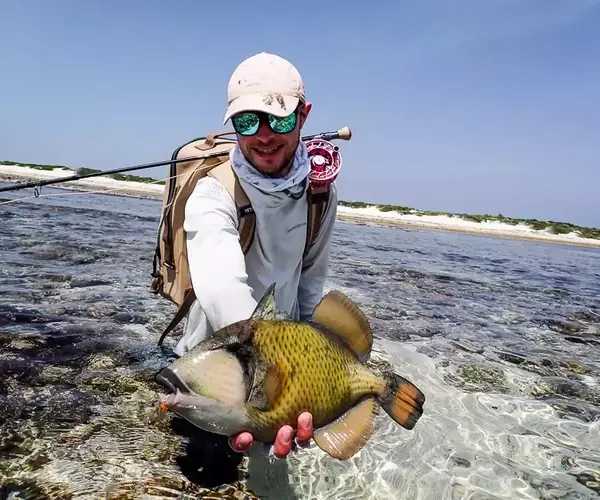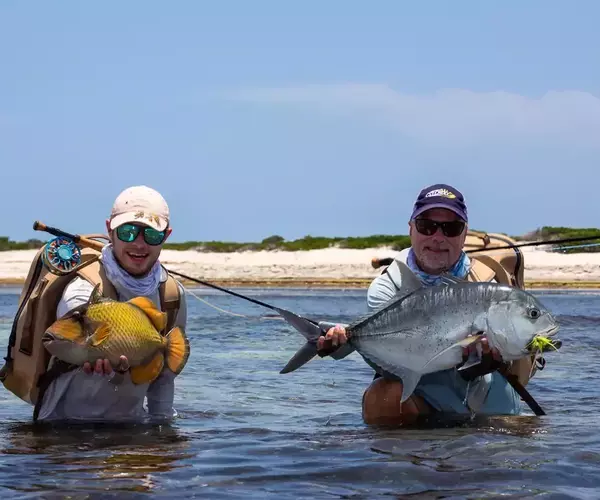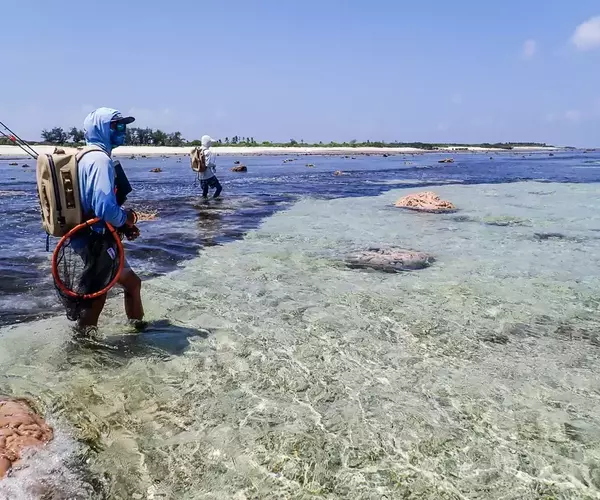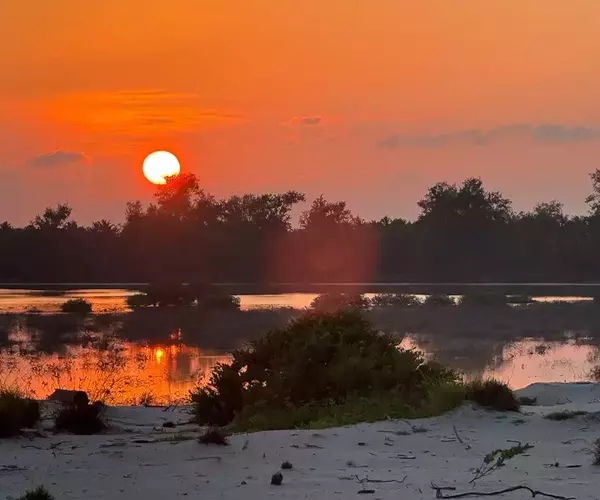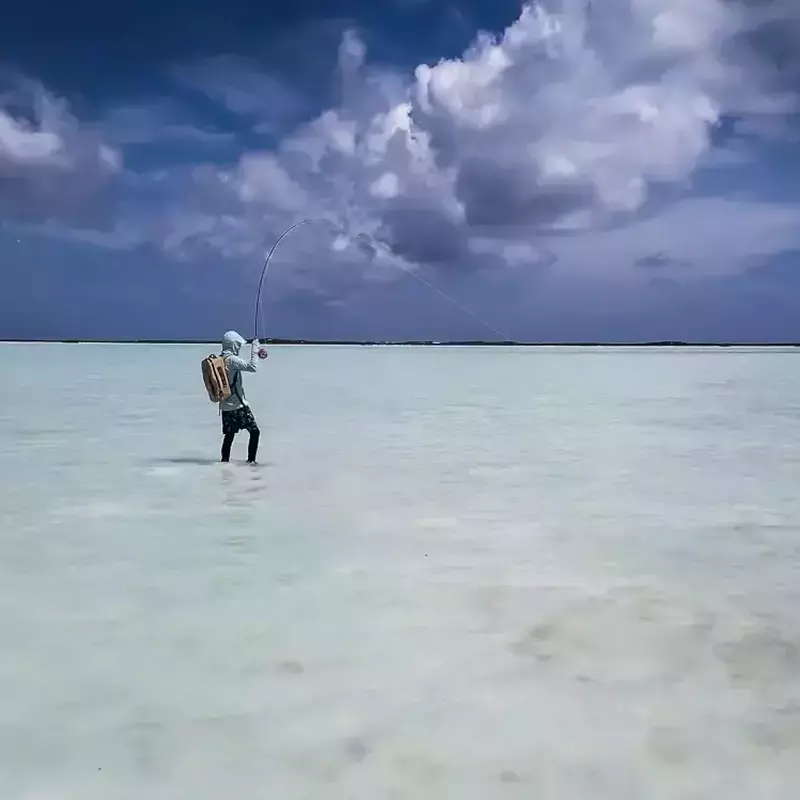Fly Fishing Astove Atoll: Giant Trevally, History, and Wilderness in the Seychelles
Remote, rugged, and ecologically rich, Astove Atoll lies at the southwestern edge of the Seychelles Outer Islands. It’s a location few people visit, but those who do tend to have a rod in hand and their sights set on the region’s apex flats predator — the giant trevally, or GT.
Astove Atoll is one of the premier Seychelles fly fishing destinations for experienced anglers in good to excellent condition. There is no entertainment, shopping, or nightlife on the atoll – visitors go there either to fly fish or to dive along the world-renowned “Astove Wall” made famous by Jacques Cousteau.
Historical Footprint: The Guano Lagoon
Astove's central lagoon is a striking feature. At first glance, it appears to be a natural part of the atoll’s topography, but in fact, it was created through guano mining operations that took place in the 19th century during the Napoleonic Wars.
The excavation left behind a shallow, enclosed basin — now a hypersaline lagoon — which provides a unique habitat and shapes the hydrodynamics of the atoll’s flats. The result is a fishing environment with varied depth, flow, and nutrient levels that attract a variety of species. Unsettled sediment gives the lagoon water its milky color.
Fly Fishing Overview: Season and Strategy
Fishing at Astove is strictly catch-and-release and managed by the Alphonse Fishing Company, which enforces sustainable practices to protect the fragile marine ecosystem. The season runs from November to April, aligning with favorable weather and tidal conditions.
This particular Seychelles fly fishing destination is best known for its wade fishing opportunities. Flats skiffs are used sparingly when tides make wading difficult, but anglers should be in excellent condition and able to confidently walk on uneven and varied flats. With just six rods allowed per week, angling pressure is minimal, and fish behavior remains natural and aggressive.
Premier Target: The Giant Trevally (GT)
Astove’s reputation as a GT hotspot is well-earned. The giant trevally here are known for their size, aggression, and the challenging terrain in which they’re often found — particularly in the surf zone and drop-offs where deep water meets the flat’s edge.
GTs regularly push baitfish up against the reef, allowing for explosive takes just meters from your boots. Astove Atoll is one of the few places where it’s possible to target GTs in shallow water on foot, giving anglers a shot at powerful fish that exceed 100 cm in length.
In addition to GTs, other game fish provide variety and technical challenges:
- Bonefish – Found on the flats, these fish are spooky but abundant.
- Triggerfish – Notably yellowmargin and moustache triggers, found tailing over coral and turtle grass.
- Milkfish – These algae eaters offer long fights and require precise presentation.
- Bluefin trevally, grouper, and barracuda – Often caught while targeting GTs or as bycatch on the reef edges.
Wildlife: Tortoises, Crabs, and Coastal Life
The island is home to giant Aldabra tortoises, descendants of those brought to the island decades ago, now roaming freely in the scrubby vegetation and coconut groves.
There’s also a remarkable diversity of crabs, including coconut crabs, ghost crabs, and fiddlers — their presence made possible by the island’s remoteness and limited development. Along the shoreline, seabirds nest in peace, while green and hawksbill turtles can be seen nesting on the beaches or foraging near the reef.
The entire island is part of a protected conservation zone, with regular scientific monitoring taking place in collaboration with marine biologists and local NGOs.
Lodging: Coral House Lodge
Guests stay at the Coral House, a simple but well-appointed lodge with rooms all surrounding a central courtyard. Accommodations are intentionally modest, in keeping with the atoll’s remote nature and conservation goals. Each guest room is air-conditioned, with en-suite bathrooms, daily laundry service, and daily housekeeping.
Meals are prepared onsite and typically feature fresh-caught fish, tropical produce, and Seychellois-style Creole dishes. Communal dining is the norm, creating a shared experience among the guests each week.
Wifi is provided, but it is much slower than most people are accustomed to these days—the focus is on the outdoors. After dinner, most guests gather in the open-air lounge to share stories and plan the next day’s fishing itinerary.
Logistics and Access
Getting to Astove is an adventure in itself. Guests first fly into Mahé, the Seychelles' main island, then take a chartered flight to Astove, operated as part of the Alphonse Fishing Company’s weekly logistics. These flights are tightly scheduled, so trip planning must be done well in advance.
All tackle, flies, and gear can be rented or purchased on location, but most experienced anglers bring their own setups tailored to the size and species they hope to target.
Final Thoughts
Astove Atoll is a specialized fly fishing destination ideal for anglers seeking a remote challenge and the chance to target GTs in one of their wildest remaining strongholds. This destination is best suited to experienced fly anglers in good to excellent physical condition. Expect the heat to be oppressive during the day, mosquitoes to be thick once the sun goes down, challenging walking on the flats, and fish that will “blow your mind!”
Contact the Alphonse Fishing Company/ Blue Safari Fly Fishing or your favorite fly fishing travel company to learn more about this and other Seychelles fly fishing destinations. Reach out to us via email for additional information about our experience at Astove Atoll in 2025, we will be happy to make gear recommendations and suggest a handful of fly patterns.

